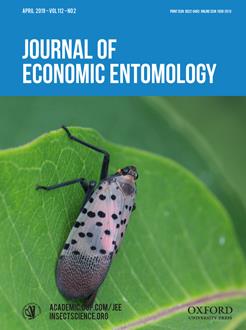The sweet potato whitefly Bemisia tabaci Genn (Hemiptera: Aleyrodidae) has been recorded to differentially prefer rosemary (Rosmarinus officinalis) varieties in commercial fields in Israel. As chemical signaling is a significant component in plant–insect interaction, the present study examined the involvement of rosemary essential oil volatiles in this differential colonization to elucidate the rosemary-whitefly ecological interaction. Thirty-two rosemary varieties with different chemical profiles were used. The average whitefly preference was 25.1% with a significant variation of 51.4%, partitioning the sampled varieties into five preference groups, hence suggesting rosemary as a non-preferred host for the insect. All relations between preference and the major volatiles 1,8-cineole, camphor, linalool, verbenone, bornyl acetate and borneol were significantly (P ≤⃒ 0.05) or notably (0.05 < P ≤⃒ 0.09) negative (r < 1). Therefore, revealing that whitefly preference for rosemary is based on a continuum of repellency rather than attraction. ‘Choice’ bioassays with a range of the major volatile concentrations and gas chromatography–mass spectrometry (GC–MS) volatile blends (fractions) validated this observation. Principle component analysis of the entire chemical profile of two extreme varieties, representing high and low preferences, identified that approximately 43% of the volatiles in the essential oil were directly associated with repellency. Keeping in mind the remaining 57% of the compounds, this myriad of volatiles exhibit the ecological complexity of the rosemarywhitefly eco-system, explaining that whitefly preference to rosemary is repellency based.
How to translate text using browser tools
10 December 2018
Rosemary–Whitefly Interaction: A Continuum of Repellency and Volatile Combinations
Dganit Sadeh,
Nadav Nitzan,
Alona Shachter,
Murad Ghanim,
Nativ Dudai
ACCESS THE FULL ARTICLE
It is not available for individual sale.
This article is only available to subscribers.
It is not available for individual sale.
It is not available for individual sale.

Journal of Economic Entomology
Vol. 112 • No. 2
April 2019
Vol. 112 • No. 2
April 2019
breeding
essential oil
integrated pest management (IPM)
preference
repellency




